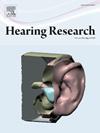No causal relationship serum lipids on age-related hearing loss based on Mendelian randomized evidence
IF 2.5
2区 医学
Q1 AUDIOLOGY & SPEECH-LANGUAGE PATHOLOGY
引用次数: 0
Abstract
Objectives
Presbycusis, or age-related hearing loss (ARHL) has been a common disability disease among the elderly population. It is particularly essential to identify the underlying role of related risk factors for ARHL diagnosis and treatment. Observational studies have shown that cardiovascular disease may be a factor in ARHL. Serum lipids are a key risk factor for cardiovascular disease. Therefore, it may be a potentially influencing factor for elderly deafness. We conduct the study to analyze the causal relationship between serum lipids and European elderly deafness.
Design
Using genetic variation data related to serum lipids (total cholesterol levels [TCL], total triglycerides levels [TGL], and lipoprotein fractions, including apolipoprotein A1 levels [APOA1L], apolipoprotein B levels [APOBL], high-density lipoprotein cholesterol levels [HDL], and low-density lipoprotein cholesterol levels [LDL]) as instrumental variables, the outcome events were summarized from the genome-wide association study data of elderly deafness, and Mendelian randomization (MR) analysis was used in our analysis. The relationship between serum lipids levels and ARHL was analyzed using five methods, including inverse variance weighted, weighted mode, MR-Egger, weighted median, and simple mode. The study aims to use bidirectional MR analysis.
Results
Among all 5 methods, no significant causal effects were found between serum lipids (TCL OR = 0.936, p = .488; TGL OR = 0.955, p = 0.657; APOA1L OR = 0.864, p = .061; APOBL OR = 0.979, p = .786; HDL OR = 0.998, p = .979; LDL OR = 1.089, p = .281) and presbycusis.
Conclusion
The findings of MR causal inference analysis did not support the causal relationship between presbycusis and serum lipids, including cholesterol, triglycerides, and lipoprotein fractions (APOA1L, APOBL, HDL and LDL).
根据孟德尔随机证据,血清脂质与老年性听力损失没有因果关系。
目的:老花眼或老年性听力损失(ARHL)是老年人口中常见的残疾疾病。确定相关风险因素对 ARHL 诊断和治疗的潜在作用尤为重要。观察性研究表明,心血管疾病可能是导致 ARHL 的一个因素。血清脂质是心血管疾病的关键风险因素。因此,它可能是老年性耳聋的潜在影响因素。我们的研究旨在分析血清脂质与欧洲老年性耳聋之间的因果关系:利用与血清脂质(总胆固醇水平 [TCL]、总甘油三酯水平 [TGL]、脂蛋白组分,包括载脂蛋白 A1 水平 [APOA1L]、载脂蛋白 B 水平 [APOBL]、高密度脂蛋白胆固醇水平 [HDL]、我们的分析采用了孟德尔随机化(MR)分析法,并从老年性耳聋的全基因组关联研究数据中总结了结果事件。我们采用了五种方法分析血清脂质水平与 ARHL 之间的关系,包括逆方差加权法、加权模式法、MR-Egger 法、加权中位数法和简单模式法。研究旨在使用双向MR分析:在所有五种方法中,血清脂质(TCL OR = 0.936,p = .488;TGL OR = 0.955,p = 0.657;APOA1L OR = 0.864,p = .061;APOBL OR = 0.979,p = .786;HDL OR = 0.998,p = .979;LDL OR = 1.089,p = .281)与老花眼之间没有发现明显的因果效应:磁共振因果推理分析结果不支持老花眼与血清脂质(包括胆固醇、甘油三酯和脂蛋白组分(APOA1L、APOBL、高密度脂蛋白和低密度脂蛋白))之间的因果关系。
本文章由计算机程序翻译,如有差异,请以英文原文为准。
求助全文
约1分钟内获得全文
求助全文
来源期刊

Hearing Research
医学-耳鼻喉科学
CiteScore
5.30
自引率
14.30%
发文量
163
审稿时长
75 days
期刊介绍:
The aim of the journal is to provide a forum for papers concerned with basic peripheral and central auditory mechanisms. Emphasis is on experimental and clinical studies, but theoretical and methodological papers will also be considered. The journal publishes original research papers, review and mini- review articles, rapid communications, method/protocol and perspective articles.
Papers submitted should deal with auditory anatomy, physiology, psychophysics, imaging, modeling and behavioural studies in animals and humans, as well as hearing aids and cochlear implants. Papers dealing with the vestibular system are also considered for publication. Papers on comparative aspects of hearing and on effects of drugs and environmental contaminants on hearing function will also be considered. Clinical papers will be accepted when they contribute to the understanding of normal and pathological hearing functions.
 求助内容:
求助内容: 应助结果提醒方式:
应助结果提醒方式:


